Analyzing Impact of Macro Environment and Stakeholder Analysis on Uber
21 Pages6396 Words1 Views
Added on 2022-12-27
About This Document
This report analyzes the impact and influence of macro environment on Uber, including PESTLE analysis and stakeholder analysis. It also assesses the internal environment and capabilities of Uber using VRIO analysis and McKinsey's 7S model.
Analyzing Impact of Macro Environment and Stakeholder Analysis on Uber
Added on 2022-12-27
ShareRelated Documents
Business Strategy
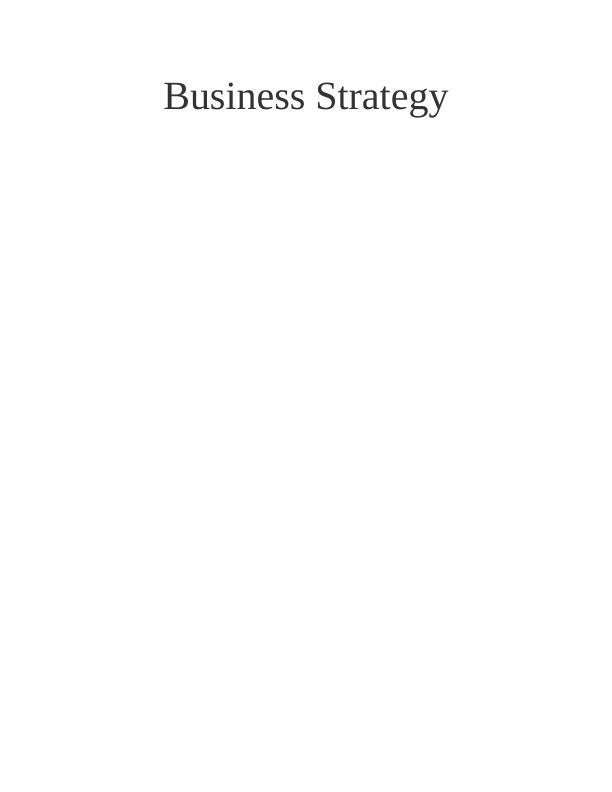
Table of Contents
INTRODUCTION...........................................................................................................................3
LO 1 Analyse impact and influence of macro environment on organisation..................................3
P1 Analyse macro environment and stakeholder analysis ....................................................3
LO 2 Assess internal environment and capabilities.........................................................................6
P2 Analyse internal environment and capabilities of Uber ..................................................6
LO 3 Porter's Five Forces................................................................................................................9
P3 Porter's five forces model..................................................................................................9
LO 4 Theories, models and concepts.............................................................................................12
P4 Theories, concepts and models, interpret strategic planning..........................................12
CONCLUSION..............................................................................................................................16
REFERENCES..............................................................................................................................17
INTRODUCTION...........................................................................................................................3
LO 1 Analyse impact and influence of macro environment on organisation..................................3
P1 Analyse macro environment and stakeholder analysis ....................................................3
LO 2 Assess internal environment and capabilities.........................................................................6
P2 Analyse internal environment and capabilities of Uber ..................................................6
LO 3 Porter's Five Forces................................................................................................................9
P3 Porter's five forces model..................................................................................................9
LO 4 Theories, models and concepts.............................................................................................12
P4 Theories, concepts and models, interpret strategic planning..........................................12
CONCLUSION..............................................................................................................................16
REFERENCES..............................................................................................................................17
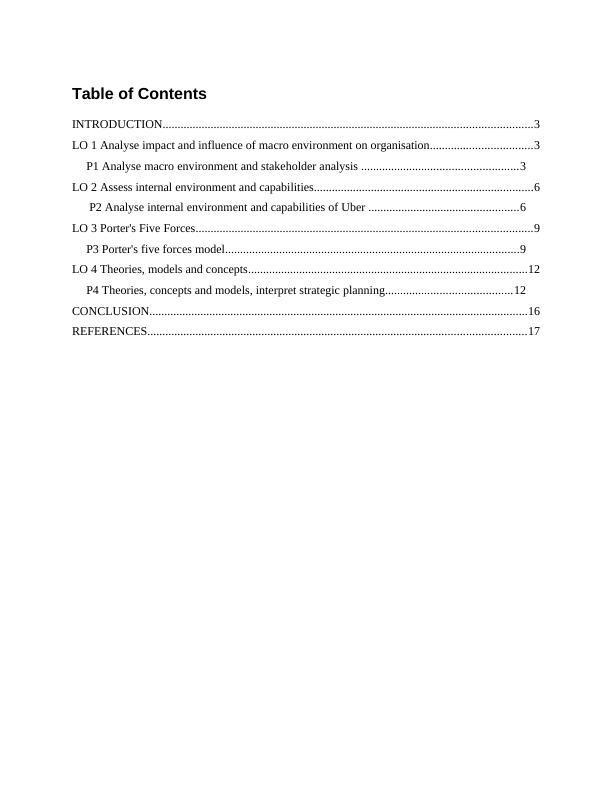
INTRODUCTION
Business strategy refers to summary of an organisation which includes goals, objectives
and ways to achieve those gaols. It can be described as long term planning of business and helps
in making decisions. It is planning process in which strategies are made for accomplishing goals
and targets of organisation. There are three types of strategy i.e., business strategy, operational
strategy and transformational strategy.
Uber technologies, Inc., is public company which was founded in year 2009 by Garrett
Camp and Travis Kalanick. It is a transportation industry which includes, package delivery,
couriers, freight transportation. Its headquarters are in San Francisco, California and U.S. Key
people of Uber company are Ronald Sugar (Chairman), Dara Khosrowshahi (CEO), Neslon Chai
(CFO), Sukumar Rathnam (CTO) and Tony West (CLO). It covers 69 countries over 900
metropolitan areas.
In the present report impact and influence of macro environment on organisation,
PESTLE analysis and stakeholder analysis is discussed and critical analysis is done. Internal
environment is analysed which includes, VRIO,McKinsey's, value chain, benchmarking is
described. Further, Porter's five forces model is described and balanced scorecard approach is
also discussed. Porter's generic strategies, hybrid strategy, diversification, external model of
Bowman's strategy is described.
LO 1 Analyse impact and influence of macro environment on organisation
P1 Analyse macro environment and stakeholder analysis
PESTLE analysis
It is a tool which is used by organisations to identify external environmental factors and
make planning and strategies according to that. PESTLE refers to different factors that affect
working of company. Factors such as, political, economic, social, technological, legal and
environmental. These are the factors that affect working of company, for smooth working of
organisation managers take actions to face these factors (Aikaterini, Ioannis and Vasilagos,
2019) .
Business strategy refers to summary of an organisation which includes goals, objectives
and ways to achieve those gaols. It can be described as long term planning of business and helps
in making decisions. It is planning process in which strategies are made for accomplishing goals
and targets of organisation. There are three types of strategy i.e., business strategy, operational
strategy and transformational strategy.
Uber technologies, Inc., is public company which was founded in year 2009 by Garrett
Camp and Travis Kalanick. It is a transportation industry which includes, package delivery,
couriers, freight transportation. Its headquarters are in San Francisco, California and U.S. Key
people of Uber company are Ronald Sugar (Chairman), Dara Khosrowshahi (CEO), Neslon Chai
(CFO), Sukumar Rathnam (CTO) and Tony West (CLO). It covers 69 countries over 900
metropolitan areas.
In the present report impact and influence of macro environment on organisation,
PESTLE analysis and stakeholder analysis is discussed and critical analysis is done. Internal
environment is analysed which includes, VRIO,McKinsey's, value chain, benchmarking is
described. Further, Porter's five forces model is described and balanced scorecard approach is
also discussed. Porter's generic strategies, hybrid strategy, diversification, external model of
Bowman's strategy is described.
LO 1 Analyse impact and influence of macro environment on organisation
P1 Analyse macro environment and stakeholder analysis
PESTLE analysis
It is a tool which is used by organisations to identify external environmental factors and
make planning and strategies according to that. PESTLE refers to different factors that affect
working of company. Factors such as, political, economic, social, technological, legal and
environmental. These are the factors that affect working of company, for smooth working of
organisation managers take actions to face these factors (Aikaterini, Ioannis and Vasilagos,
2019) .
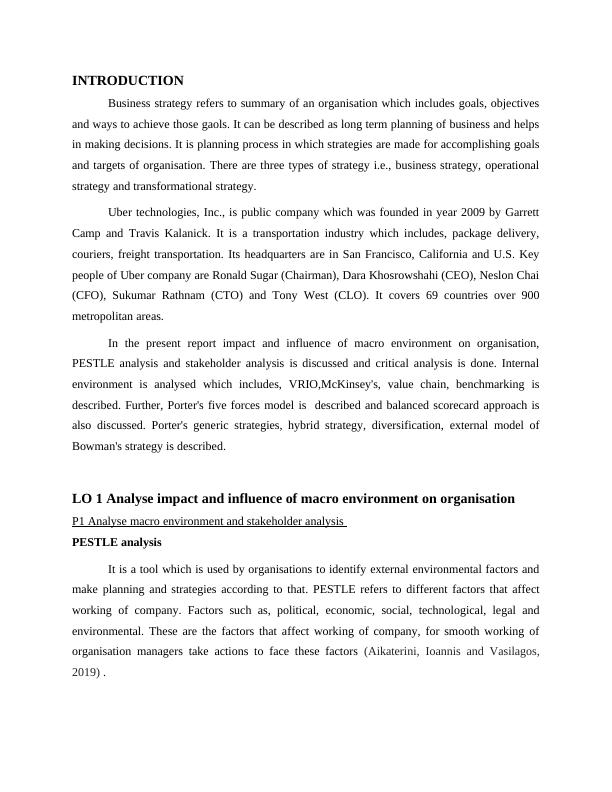
Political factor : These factor determine extent to which government influences
economy or affect plans of industry. Changes in tax policy by government, fiscal policy, trade
tariffs, or make improvements in other policies affect the working of organisation. Managers of
company set some plans for such situations and they try that company should not suffer loss.
Uber has faced many problems as there was no clear rules and regulations. In France they filed
charges based on advertising, Netherlands ruled against Uber as their drivers are not having
licences for taxis, and many other in different countries.
All nations are having different rules, policies and regulations so it takes time for new
organisation to adjust. Culture, trends, taste and preferences vary from one country to other
country. Further, there were some discussions regarding minimum wage laws and government
requires documents from Uber. Company has to follow different rules of various countries as
they expand their business. In some places organisations has to pay high tax rate.
Economic factors : These factors include, inflation rate, interest rates, exchange rate,
pattern of economic growth. Uber operates sharing economy which means sharing of physical or
intellectual resources. Uber drivers respond properly to customers and drive them to exact
location where they want to reach. The prices of Uber taxis are low as compare to other taxis and
it is easy to book. Many countries banned services of Uber as they are good competitors for other
taxi drivers. They face many problems and after competing with all these situations they build
good image in market.
Social factors : These factors include environment and culture of market or society such
as, cultural trends, demographics, population analytics etc. Different products are made by
organisation to attract customers and satisfy them. Customers of Uber enjoy their services and it
is easy to access. Consumers are enjoying rides, they are sharing their views by giving good
feedback and good reviews on social networking sites. Uber provides good services which attract
customers and they also use some amount from their profit for benefit of society (Yuan and
et.al., 2020).
So it is important for organisations to satisfy customers because good image can be build
only when customers are happy. People are using more Uber services rather than local or public
transportation facilities.
economy or affect plans of industry. Changes in tax policy by government, fiscal policy, trade
tariffs, or make improvements in other policies affect the working of organisation. Managers of
company set some plans for such situations and they try that company should not suffer loss.
Uber has faced many problems as there was no clear rules and regulations. In France they filed
charges based on advertising, Netherlands ruled against Uber as their drivers are not having
licences for taxis, and many other in different countries.
All nations are having different rules, policies and regulations so it takes time for new
organisation to adjust. Culture, trends, taste and preferences vary from one country to other
country. Further, there were some discussions regarding minimum wage laws and government
requires documents from Uber. Company has to follow different rules of various countries as
they expand their business. In some places organisations has to pay high tax rate.
Economic factors : These factors include, inflation rate, interest rates, exchange rate,
pattern of economic growth. Uber operates sharing economy which means sharing of physical or
intellectual resources. Uber drivers respond properly to customers and drive them to exact
location where they want to reach. The prices of Uber taxis are low as compare to other taxis and
it is easy to book. Many countries banned services of Uber as they are good competitors for other
taxi drivers. They face many problems and after competing with all these situations they build
good image in market.
Social factors : These factors include environment and culture of market or society such
as, cultural trends, demographics, population analytics etc. Different products are made by
organisation to attract customers and satisfy them. Customers of Uber enjoy their services and it
is easy to access. Consumers are enjoying rides, they are sharing their views by giving good
feedback and good reviews on social networking sites. Uber provides good services which attract
customers and they also use some amount from their profit for benefit of society (Yuan and
et.al., 2020).
So it is important for organisations to satisfy customers because good image can be build
only when customers are happy. People are using more Uber services rather than local or public
transportation facilities.

Technological factors : It refers to innovation in technology that affect working of
organisation. As today there is rapid change in technology, new machines and ideas are used by
companies to increase their revenue. This also refers to research and development and
technological awareness. Companies should use the latest techniques for attracting more
revenues.
Uber is famous because people are sharing their views on social media which is used by most of
the people. This is use of the latest technology as in today's digital world all people are having
smartphones and uber is having its own app. Buyers want good services at low prices and this
need is fulfilled by company. After booking an appointment taxi reaches to location within 10 to
15 minutes.
Legal factors : It includes both internal and external factors. There are some laws which
affect working of the company and some policies and rules are made by organisation for
themselves. There are various laws such as , consumer law, safety and security of employees,
labor laws. Uber company is applying consumer law and safety law in their company for
satisfaction of employees (Moktadir, and et.al., 2020).
Environmental factors : These factors include all those factors that is influenced by
surroundings. Uber company contributes some part of its profits to corporate social responsibility
and sustainability. CSR is a management concept in which organisation integrate social concerns
in their business. The purpose of CSR is to give back to society and provide positive social
value.
These are some external factors that affect performance of organisation, these are
uncontrollable factors. There is positive and negative impact of PESTLE on company. Positive
impact is that it helps in identifying issues or problems that arise when working and also affect
profit of company. Company should be prepare to face challenges and compete with them to
maintain its position. Negative impact of PESTLE is that if measures are not taken then company
can suffer loss and these factors changes frequently, no time is available for managers of
organisation to change strategies. So, they should make rules and policies according to changes
and be ready to face problems. Uber has faced both negative and positive effects of PESTLE and
now it has become famous in all over the world (Maniora, 2018).
STAKEHOLDER ANALYSIS
organisation. As today there is rapid change in technology, new machines and ideas are used by
companies to increase their revenue. This also refers to research and development and
technological awareness. Companies should use the latest techniques for attracting more
revenues.
Uber is famous because people are sharing their views on social media which is used by most of
the people. This is use of the latest technology as in today's digital world all people are having
smartphones and uber is having its own app. Buyers want good services at low prices and this
need is fulfilled by company. After booking an appointment taxi reaches to location within 10 to
15 minutes.
Legal factors : It includes both internal and external factors. There are some laws which
affect working of the company and some policies and rules are made by organisation for
themselves. There are various laws such as , consumer law, safety and security of employees,
labor laws. Uber company is applying consumer law and safety law in their company for
satisfaction of employees (Moktadir, and et.al., 2020).
Environmental factors : These factors include all those factors that is influenced by
surroundings. Uber company contributes some part of its profits to corporate social responsibility
and sustainability. CSR is a management concept in which organisation integrate social concerns
in their business. The purpose of CSR is to give back to society and provide positive social
value.
These are some external factors that affect performance of organisation, these are
uncontrollable factors. There is positive and negative impact of PESTLE on company. Positive
impact is that it helps in identifying issues or problems that arise when working and also affect
profit of company. Company should be prepare to face challenges and compete with them to
maintain its position. Negative impact of PESTLE is that if measures are not taken then company
can suffer loss and these factors changes frequently, no time is available for managers of
organisation to change strategies. So, they should make rules and policies according to changes
and be ready to face problems. Uber has faced both negative and positive effects of PESTLE and
now it has become famous in all over the world (Maniora, 2018).
STAKEHOLDER ANALYSIS
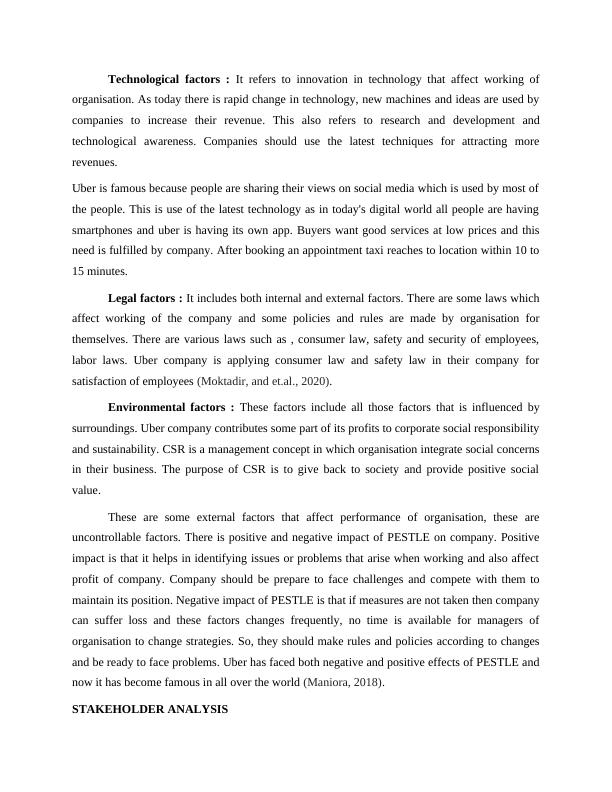
Stakeholder analysis is the process of systematically collecting and analysing information
which helps in determining whose interest is taken when developing policy. It helps in
identifying people before implementing project. It determines the best way to involve and
communicate each of stakeholders. When shareholders analysis is done it is great way to provide
good quality products, it helps in understanding different stakeholders of product and how they
can affect project. It removes barriers and project can be understand by analysing shareholder.
Shareholders are persons who are actively participating in decisions related to projects as
they are affected by result of project. In companies most of the decisions are taken by
shareholders, team members of project, so they play important role in successful delivery of
project. Stakeholder analysis is important as it helps in shaping the project, building trust,
winning additional benefits, stay ahead of competition (Chen, Eshleman and Soileau, 2017).
In Uber company stakeholder analysis is done to identify risk and requirement of project. It also
helps in managing expenses that are required for implementing project, it builds trust and
determine various aspects of project development.
Mendlow's stakeholder matrix
It is a tool that is used by the company to understand the behaviour of stakeholders in the
beginning of the project or when managers are making plans or strategies to achieve goals and
objectives of the company. In this there are four parts, minimal effort, keep informed, keep
satisfied and key players. The stakeholders put minimum effort, they gather all the information
from managers of company. It is important to keep them satisfied and they are the key players.
This is stakeholder matrix which is used by Uber company to satisfy owners and build good
reputation in the market.
LO 2 Assess internal environment and capabilities
P2 Analyse internal environment and capabilities of Uber
Internal environment refers to culture of organisation, members, events and factors that
influence decision making of company. There are various types of environmental factors such as,
plans and policies, human resource, value proposition, labour management, inter person
relationship with employees.
which helps in determining whose interest is taken when developing policy. It helps in
identifying people before implementing project. It determines the best way to involve and
communicate each of stakeholders. When shareholders analysis is done it is great way to provide
good quality products, it helps in understanding different stakeholders of product and how they
can affect project. It removes barriers and project can be understand by analysing shareholder.
Shareholders are persons who are actively participating in decisions related to projects as
they are affected by result of project. In companies most of the decisions are taken by
shareholders, team members of project, so they play important role in successful delivery of
project. Stakeholder analysis is important as it helps in shaping the project, building trust,
winning additional benefits, stay ahead of competition (Chen, Eshleman and Soileau, 2017).
In Uber company stakeholder analysis is done to identify risk and requirement of project. It also
helps in managing expenses that are required for implementing project, it builds trust and
determine various aspects of project development.
Mendlow's stakeholder matrix
It is a tool that is used by the company to understand the behaviour of stakeholders in the
beginning of the project or when managers are making plans or strategies to achieve goals and
objectives of the company. In this there are four parts, minimal effort, keep informed, keep
satisfied and key players. The stakeholders put minimum effort, they gather all the information
from managers of company. It is important to keep them satisfied and they are the key players.
This is stakeholder matrix which is used by Uber company to satisfy owners and build good
reputation in the market.
LO 2 Assess internal environment and capabilities
P2 Analyse internal environment and capabilities of Uber
Internal environment refers to culture of organisation, members, events and factors that
influence decision making of company. There are various types of environmental factors such as,
plans and policies, human resource, value proposition, labour management, inter person
relationship with employees.
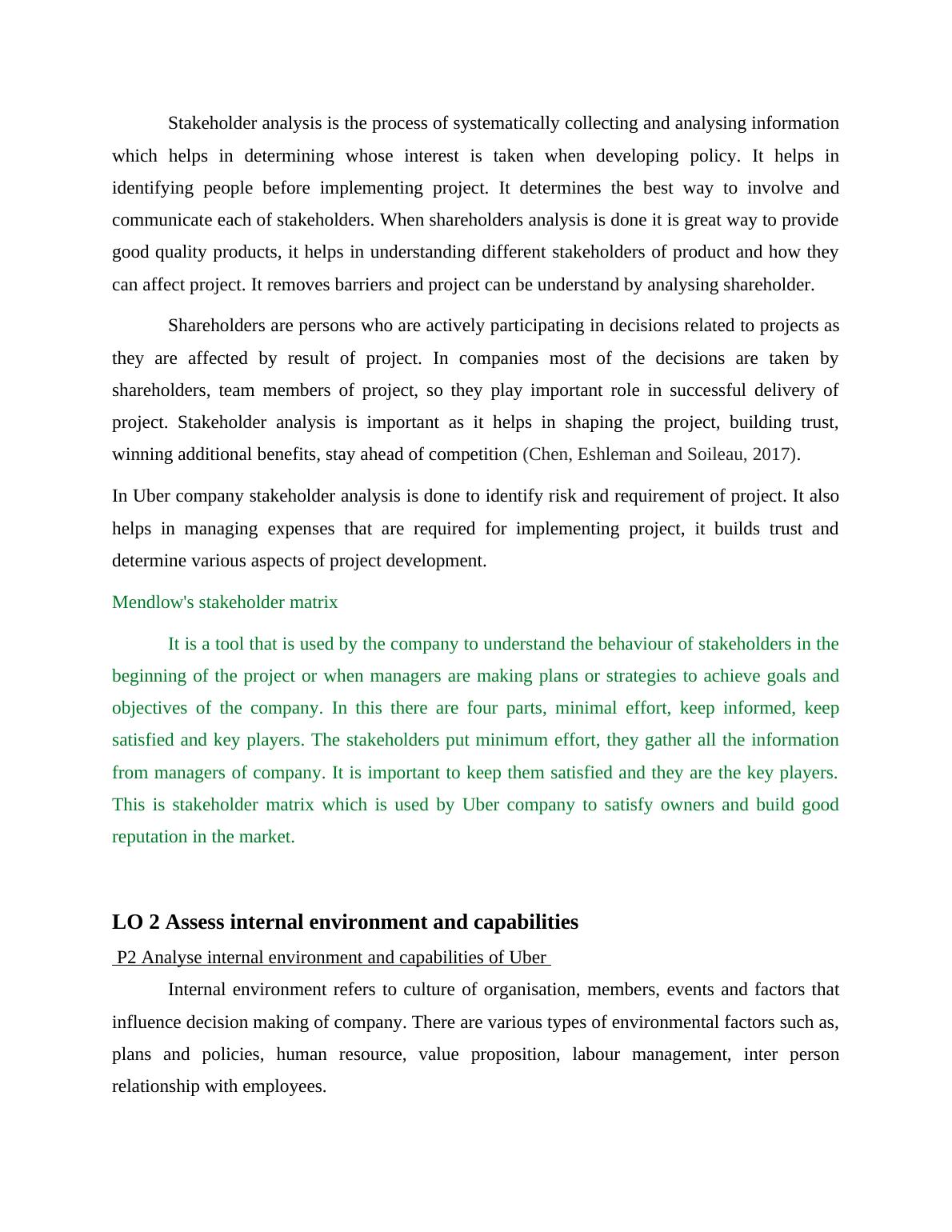
End of preview
Want to access all the pages? Upload your documents or become a member.
Related Documents
Analyzing the Impact of Macro Environment on UBER's Strategieslg...
|20
|5050
|46
Analyzing the Impact of Macro Environment on Business Strategy of UBERlg...
|16
|5391
|41
Impact and Influence of Macro Environmentlg...
|19
|5413
|345
Analyzing the Internal and External Factors Impacting Uberlg...
|18
|6092
|434
Impact of Macro Environment on Uber's Strategieslg...
|17
|4983
|75
Impact and Influence of Macro Environment on Uberlg...
|17
|5355
|36
